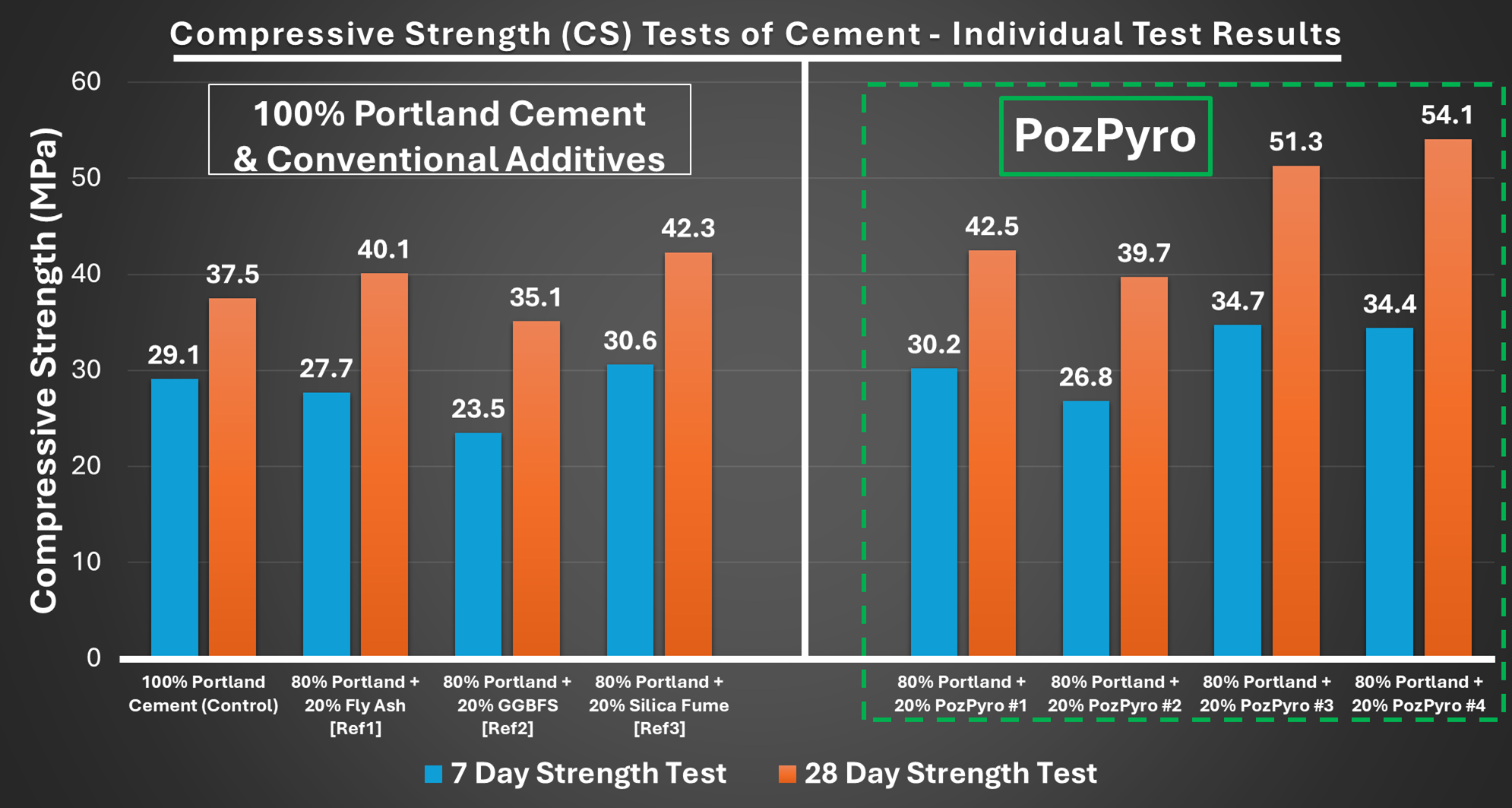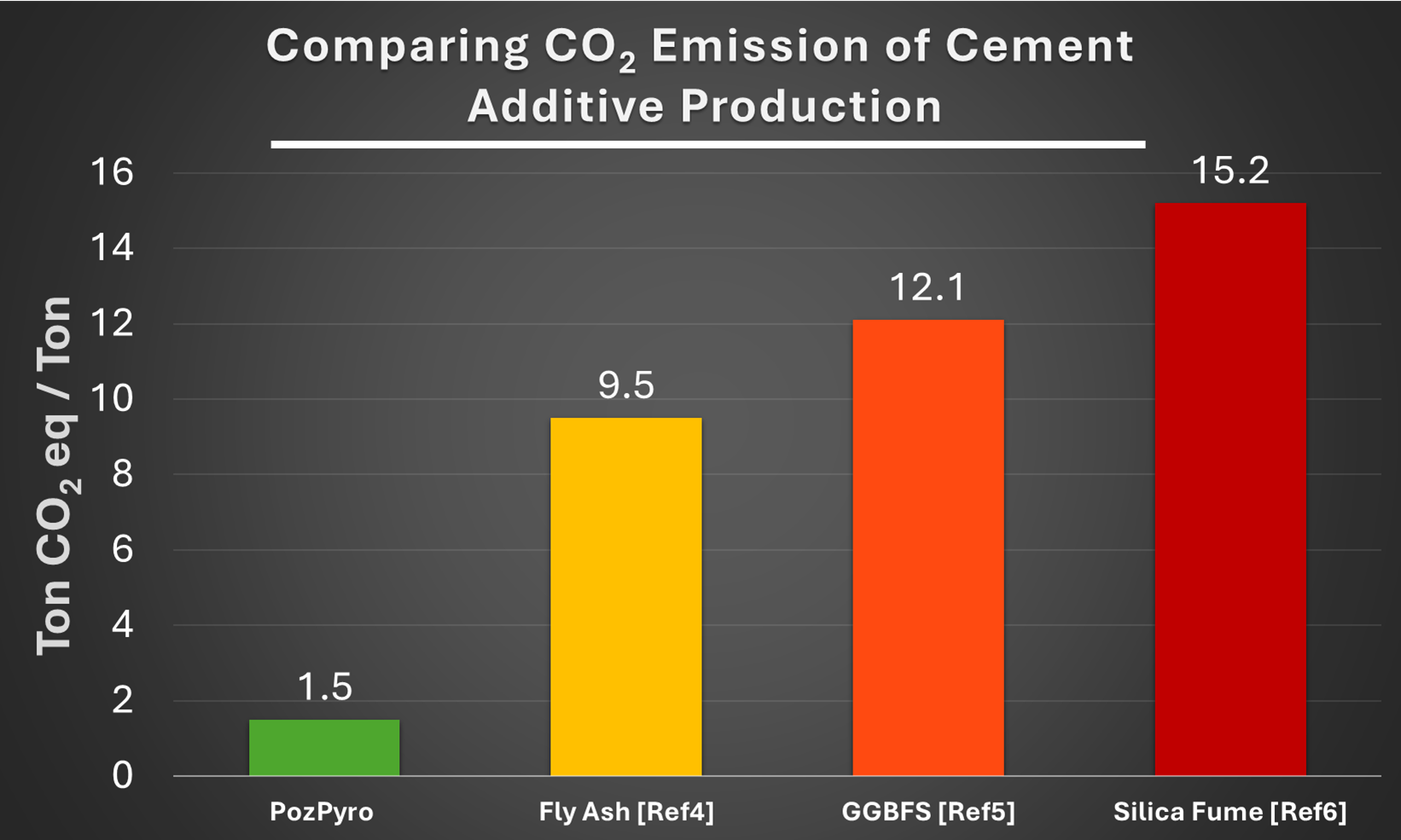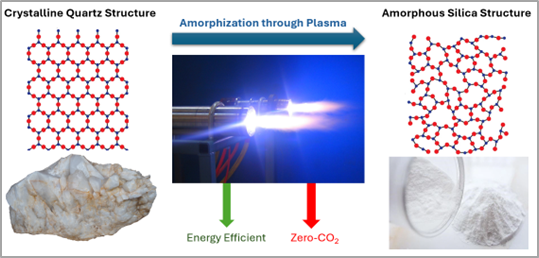Results surpass Portland Cement plus all traditional cement additive blends in pursuit of fly ash replacement in cement.
MONTREAL, May 02, 2024 (GLOBE NEWSWIRE) -- PyroGenesis Canada Inc. (http://pyrogenesis.com) (TSX: PYR) (OTCQX: PYRGF) (FRA: 8PY), a high-tech company (the “Company” or “PyroGenesis”) that designs, develops, manufactures and commercializes advanced plasma processes and sustainable solutions which are geared to reduce greenhouse gases (GHG) and address environmental pollutants, is pleased to announce today that it has been advised by its client, Progressive Planet, that the latest series of compressive strength tests on its PozPyro green cement additive product reveal impressive results, posting strength comparisons significantly above the acceptable standard for similar material. PozPyro enhances the strength of concrete as a replacement for fly ash, which is in diminishing supply.
PozPyro, a cement alternative, is being developed in collaboration with Progressive Planet as a supplementary cementing material (SCM) designed to partially replace traditional Portland Cement. Of note, Portland Cement emits substantial amounts of CO 2 during its production. PozPyro, on the other hand, is created by using a PyroGenesis plasma-based process that transforms quartz silica, a widely available material, into a SCM (PozPyro), without off-gassing CO 2 during the production process. This innovation comes at a time when the cement industry seeks more sustainable practices without compromising quality or performance.
“Quartz silica is one of the most abundant materials in the earth’s crust,” said P. Peter Pascali, President and CEO of PyroGenesis. “The ability to economically convert it into PozPyro could offer a new supply of material to compensate for the diminishing supply of fly ash, a common SCM, which, by the way, is generated by the same coal fired power plants which are being targeted for shut down in Canada by 2030.”
According to Progressive Planet’s news release today, concrete producers are looking for SCMs that (i) increase the compressive strength of their mix while at the same time (ii) lowering their carbon footprint without sacrificing workability.
WORKABILITY
The workability of cement is measured by water demand and is a measure of its ease of use in various concrete applications. The smaller the water demand number, the better the reading. A passing water demand number must be less than 115% of the water demand of the control mix.
The water demand for PozPyro was between 99% and 109% for all test batches and as such PozPyro demonstrated excellent workability.
STRENGTH ACTIVITY INDEX (SAI)
The SAI is an industry standard for measuring the compressive strength of cement mortar cubes. As announced in a press release on April 11, 2024, the results of the 7-day testing that showed an approximate average +45% SAI gain across four tests against the minimum target value.
In the 28-day tests announced today, Portland Cement was used as the control product, with varied compressive strengths between 35.26 and 39.62 megapascals (MPa) depending on the test.
These tests were conducted in two series, A and B, with two tests in each series, using different input variables to test for optimized results.
TESTING AGAINST MINIMUM COMPLIANCE (75% PORTLAND CEMENT MPA)
For SAI tests, a cement additive product test is acceptable at a minimum strength of 75% of the control product strength. i For one Series B test, the Portland Cement control achieved a compressive strength value of 36.18 MPa at 28 days. An additive product would therefore be acceptable based on achieving 27.14 MPa (equating to 75% of the Portland Cement control strength).
The results for the individual Series B test showed a blend of Portland Cement containing 20% PozPyro far surpassed this target, achieving a peak result of 54.15 MPa – a result 99.56% higher than the minimum acceptable value.
The overall average gain for all tests in both series A and B was +67.43% against the minimum compliant for an acceptable cement additive product.
TESTING AGAINST MAXIMUM COMPLIANCE (100% PORTLAND CEMENT MPA)
When compared to a 100% value of Portland Cement alone, this same Series B PozPyro/Portland Cement blend test surpassed even the full-strength value of the Portland Cement control product by up to 49.67%.
The overall average gain for all tests in both series A and B was +25% against the maximum product compliance for an acceptable cement additive product. This result means that the PozPyro material, when added to Portland Cement at a 20%/80% blend, outperformed a cement-only Portland Cement control in strength tests by 25%.

“These 28-day test results confirm the impressive results achieved by the previous 7-day tests, and underscore yet again the potential transformative nature of plasma in producing materials, in both an economically and environmentally beneficial manner, that are key to heavy industry,” said P. Peter Pascali, President and CEO of PyroGenesis. “Not only were we able to far surpass the minimum acceptable product standard compared to 75% of the control, but when compared to a full value of the control the PozPyro green cement additive showed a 49.67% gain. In other words, these tests suggest that not only can PozPyro potentially outperform other traditional cement additive products in strength, it has the potential to directly outperform pure cement alone. As I’ve stated before, the cement industry is a key target for us, and we have high expectations for the PozPyro green cement additive material.”

Image 1: A comparison of the four individual Series A and Series B strength tests, measured at 7- and 28-days in megapascals (MPa) of a 20% PozPyro/80% Portland Cement blend against a 100% pure Portland Cement control, a 20% fly ash blend, a 20% ground granulated blast-furnace slag (GGBFS) blend, and a 20% silica fume blend produced using traditional methods.
Steve Harpur, CEO of Progressive Planet, commented on the results over the last month during which Progressive Planet prepared four separate batches of cement mortar cubes to test, under the American Society for Testing and Materials (“ASTM”) testing protocol, at both 7 and 28 days for compressive strength: “These results were exceptional and provide us the technical confidence to take the next steps to bring this product to market. In the Pacific Northwest alone, over one million tons of fly ash will cease to be generated by the summer of 2025 at which time two massive thermal coal to energy facilities will have finished converting from burning coal to natural gas.”

Image 2: A comparison of the Series A and Series B strength tests, measured at 7- and 28-days in megapascals (MPa) of a 20% PozPyro/80% Portland Cement blend, using averages of each of two tests within both Series A and Series B, against 100% pure Portland Cement control, 20% fly ash blend, 20% ground granulated blast-furnace slag (GGBFS) blend, and 20% silica fume blend.
CO 2 EMISSIONS / LACK THEREOF
While compressive strength is key to overall product viability, the reduction of CO 2 emissions achieved by using PyroGenesis’ plasma technology, a low carbon emitting process, has the potential to offer further “green” benefits.
CO 2 emissions within a product lifecycle are defined globally within 3 categories: Scope 1, Scope 2, and Scope.
Generally speaking:
- Scope 1 emissions are direct greenhouse gas emissions caused by the company’s production processes.
- Scope 2 emissions are indirect emissions, that factors in the use of energy purchased externally (and the CO 2 created as a result of that energy being originally produced).
-
Scope 3
emissions represent the CO
2
emissions
from operations upstream and downstream
of the company’s operations, such as raw material production, transportation, waste, and end of life remediation.
When compared to other traditional cement additives, the production of PozPyro may result in dramatically lower CO 2 emissions. For the purposes of the graph below, Scope 2 emissions regarding electricity usage have been factored into PozPyro’s emission level. Without these Scope 2 emissions, the greenhouse gas emissions released during the production of PozPyro may be virtually zero.

Image 3: A comparison of CO 2 emitted during the production of 1 tonne of PozPyro vs. other cement additive products. CO 2 emission assigned to PozPyro comes from production of electricity subsequently used by the process, not from the process itself.
“These are the best results we have ever seen in an alternative cementing material. The fact that silica-based cements do not off gas CO 2 is an additional bonus to the exceptional compressive strength results,” added Steve Gurney, President of Progressive Planet.

Image 4: A zero-CO 2 , energy-efficient conversion of crystalline quartz to amorphous silica through PyroGenesis’ plasma process.
POTENTIAL ADRESSABLE MARKET
According to Progressive Planet’s press release of today, it was noted that the North American cement market size reached 194.2 million US tons in 2023, and they expect that it will reach 279.8 million tons by 2032, reflecting an annual growth rate of 4% between 2024 and 2032. Assuming that pozzolanic cements could be a substitute for 20% of Portland Cement, the total addressable North American market is projected to reach over 55 million tons by 2032. At a projected price of US$200 per ton by 2032, the potential market is over $11 billion USD per annum by that time.
NEXT STEPS: PILOT PLANT
Now that the compressive strength of PozPyro has been validated, the next critical step is to progress towards the Pilot Plant stage. In preparation for this phase, an engineering feasibility study will be conducted over the next several months. This comprehensive study will focus on quantifying various critical elements to ensure the economic viability of the pilot plant operations. Key considerations will include maximizing heat recovery and other efficiency metrics, which are essential for sustainable and cost-effective production.
We are committed to rigorous evaluation and optimization processes, aiming to address all technical and economic aspects of the pilot plant. Updates on our progress and findings from the feasibility study will be provided in due course, as we move closer to achieving a fully operational pilot plant that meets our high standards for innovation and efficiency.
PyroGenesis’ involvement in developing PozPyro from quartz is part of PyroGenesis’ three-tiered solution ecosystem that aligns with economic drivers that are key to global heavy industry. PozPyro is part of PyroGenesis’ Commodity Security & Optimization tier, where the recovery of viable metals and the optimization of production to increase output helps to maximize raw materials and improve the availability of critical minerals.
About PyroGenesis Canada Inc.
PyroGenesis Canada Inc., a high-tech company, is a proud leader in the design, development, manufacture and commercialization of advanced plasma processes and sustainable solutions which reduce greenhouse gases (GHG) and are economically attractive alternatives to conventional “dirty” processes. PyroGenesis has created proprietary, patented and advanced plasma technologies that are being vetted and adopted by multiple multibillion dollar industry leaders in four massive markets: iron ore pelletization, aluminum, waste management, and additive manufacturing. With a team of experienced engineers, scientists and technicians working out of its Montreal office, and its 3,800 m 2 and 2,940 m 2 manufacturing facilities, PyroGenesis maintains its competitive advantage by remaining at the forefront of technology development and commercialization. The operations are ISO 9001:2015 and AS9100D certified, having been ISO certified since 1997. For more information, please visit: www.pyrogenesis.com .
About Progressive Planet
Progressive Planet is a CleanTech and manufacturing company with proven product lines based in Kamloops, British Columbia. The company’s expertise lies in developing critical low-carbon and carbon sequestering solutions using our owned mineral assets and recycled materials to create planet-friendly products that fight climate change and protect our planet's health.
Progressive Planet products are in 10,000+ retail stores across North America. Progressive Planet’s innovations, created at their C-Quester™ Centre of Sustainable Innovation, bring positive disruption to the cement, agricultural and animal-care sectors.
Cautionary and Forward-Looking Statements
This press release contains “forward-looking information” and “forward-looking statements” (collectively, “forward-looking statements”) within the meaning of applicable securities laws. In some cases, but not necessarily in all cases, forward-looking statements can be identified by the use of forward-looking terminology such as “plans”, “targets”, “expects” or “does not expect”, “is expected”, “an opportunity exists”, “is positioned”, “estimates”, “intends”, “assumes”, “anticipates” or “does not anticipate” or “believes”, or variations of such words and phrases or state that certain actions, events or results “may”, “could”, “would”, “might”, “will” or “will be taken”, “occur” or “be achieved”. In addition, any statements that refer to expectations, projections or other characterizations of future events or circumstances contain forward-looking statements. Forward-looking statements are not historical facts, nor guarantees or assurances of future performance but instead represent management’s current beliefs, expectations, estimates and projections regarding future events and operating performance.
Forward-looking statements are necessarily based on a number of opinions, assumptions and estimates that, while considered reasonable by the Company as of the date of this release, are subject to inherent uncertainties, risks and changes in circumstances that may differ materially from those contemplated by the forward-looking statements. Important factors that could cause actual results to differ, possibly materially, from those indicated by the forward-looking statements include, but are not limited to, the risk factors identified under “Risk Factors” in the Company’s latest annual information form, and in other periodic filings that the Company has made and may make in the future with the securities commissions or similar regulatory authorities, all of which are available under the Company’s profile on SEDAR+ at www.sedarplus.ca. These factors are not intended to represent a complete list of the factors that could affect the Company. However, such risk factors should be considered carefully. There can be no assurance that such estimates and assumptions will prove to be correct. You should not place undue reliance on forward-looking statements, which speak only as of the date of this release. The Company undertakes no obligation to publicly update or revise any forward-looking statement, except as required by applicable securities laws.
Neither the Toronto Stock Exchange, its Regulation Services Provider (as that term is defined in the policies of the Toronto Stock Exchange) nor the OTCQX Best Market accepts responsibility for the adequacy or accuracy of this press release.
For further information please contact:
Rodayna Kafal, Vice President, IR/Comms. and Strategic BD
E-mail:
ir@pyrogenesis.com
http://www.pyrogenesis.com
Images accompanying this announcement are available at:
https://www.globenewswire.com/NewsRoom/AttachmentNg/e7927011-62b4-476f-b155-1a2ba79ac776
https://www.globenewswire.com/NewsRoom/AttachmentNg/e9166c75-8f46-4dff-85c8-429d193036a2
https://www.globenewswire.com/NewsRoom/AttachmentNg/161e5fa6-8a35-4b6b-b695-812373c63829
https://www.globenewswire.com/NewsRoom/AttachmentNg/9a2b016c-c7be-4dff-8c19-4705685a25ef
https://www.pyrogenesis.com/wp-content/uploads/2024/04/pyrogenesis-quartz-to-amorphous-silica.png
References
[1]
Lo, F. C., Lee, M. G., & Lo, S. L. (
2021
). Effect of coal ash and rice husk ash partial replacement in ordinary Portland cement on pervious concrete.
Construction and Building Materials
,
286
, 122947.
[2]
Kathirvel, P., & Murali, G. (
2023
). Effect of using available GGBFS, silica fume, quartz powder and steel fibres on the fracture behavior of sustainable reactive powder concrete.
Construction and Building Materials
,
375
, 130997.
[3]
Uddin, M. A., Bashir, M. T., Khan, A. M., Alsharari, F., Farid, F., & Alrowais, R. (
2023
). Effect of Silica Fume on Compressive Strength and Water Absorption of the Portland Cement–Silica Fume Blended Mortar.
Arabian Journal for Science and Engineering
, 1-9.
[4]
Sævarsdottir, G., Kvande, H., & Magnusson, T. (
2021
). Greenhouse gas emissions from silicon production-development of carbon footprint with changing energy systems. In
Proceedings of the 16th International Ferro-Alloys Congress (INFACON XVI)
.
[5]
Manjunatha, M., Preethi, S., Mounika, H. G., & Niveditha, K. N. (
2021
). Life cycle assessment (LCA) of concrete prepared with sustainable cement-based materials.
Materials Today: Proceedings
,
47
, 3637-3644.
[6]
Habert, G., Miller, S. A., John, V. M.,Provis, J. L., Favier, A., Horvath, A., & Scrivener, K. L. (
2020
). Environmental impacts and decarbonization strategies in the cement and concrete industries.
Nature Reviews Earth & Environment
,
1
(11), 559-573.
i https://www.astm.org/c0618-12.html



